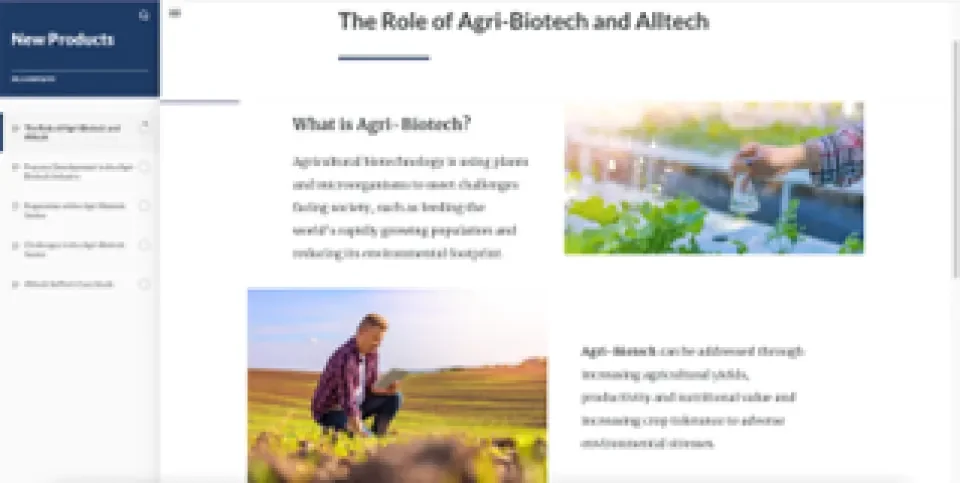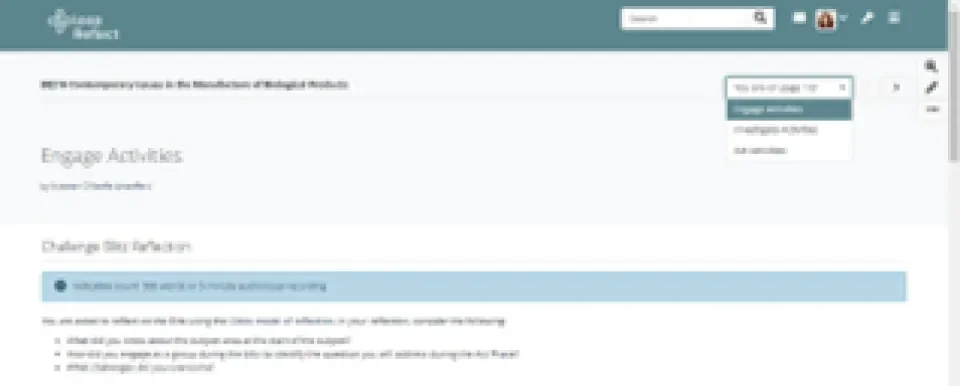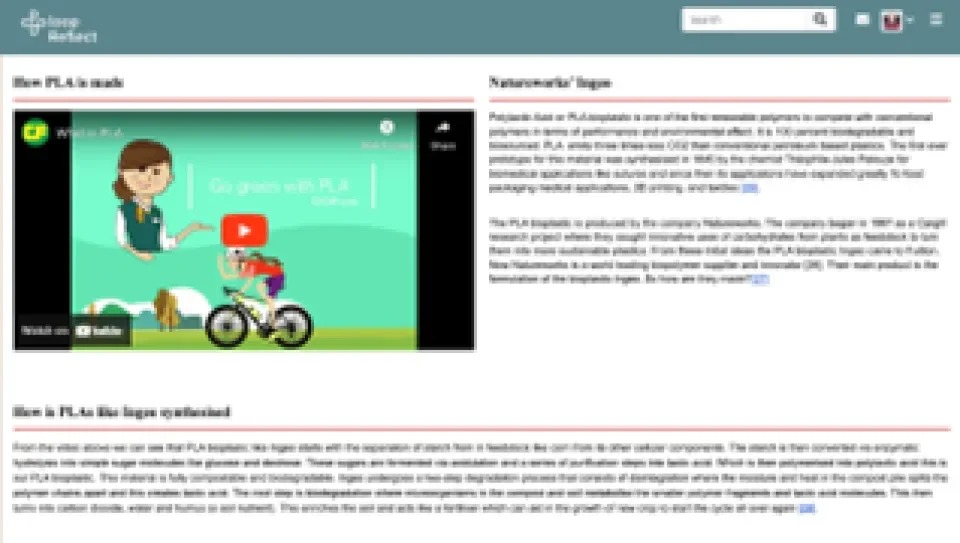
Using Challenge-Based Learning for Contemporary Bioprocessing Education
| Lecturer: | Dr Alex Eustace alex.eustace@dcu.ie; Allison Tipping allison.tipping@dcu.ie |
| Discipline: | Bioprocessing |
| Subject: | 5 ECTS credit module titled ‘Contemporary issues in the manufacture of biological products’ (BE216). This module is part of the DCU Futures programme. |
| Level: | Second year undergraduate students - level 8 |
| Class Size: | circa. 17 students |
| Mode of Delivery | Blended |
What was the teaching problem/issue/challenge you faced?

Figure 1: Sample from interactive book resource
Since the COVID-pandemic the Biopharmaceutical industry is facing major challenges. These relate to issues such as supply chain, novel drugs development, big data and food security. As part of the DCU Futures programme, BE216 was designed to encourage students to propose and investigate a solution to one of these challenges. These challenges may be of a scientific, medical, economic significance and should be associated with the broad area of the manufacture of biological products.

Figure 2: BE216 Course Page
A key teaching objective was to get the students to engage in self-directed learning and research, while trying to ensure that their investigations used up-to-date, real world issues that exist in the Bioprocessing industry. Also, we wanted their engagement with the material and each other to develop transversal skills, specifically teamwork, collaboration, project management, leadership, critical thinking and presentation skills.
What specifically did you decide to do?
Students initially engaged in a mix of in-person and online learning around critical challenges that the biotechnology sector faces, focusing on the topics of ‘Vaccine Production’, ‘New Product Release’, ‘Sustainability’ and ‘Big Data’.

Figure 3: Invited industry experts
To ensure that the challenges the students worked on were up-to-date, real-world issues, the first four weeks involved lectures from invited industrial experts, i.e. current stakeholders in the Bioprocessing field. These experts introduced current challenges and scientific developments in each of the four topic areas.
Next the students attended a 2-3 hour Challenge Definition Blitz, where they were randomly grouped, and worked intensely and collaboratively to identify a challenge within their topic.
This session was student-led. They were encouraged to use the knowledge from the industrial stakeholders, the CBL Framework, and their critical investigations to develop their team’s challenge definition. Immediately afterwards they were asked to reflect on the Blitz.
During the following five weeks the students attended facilitated tutorials with the two module lecturers and worked in their groups to further investigate their challenge. They leveraged the expert material provided to guide and refine their challenge solution. Teamwork and collaboration helped them progress through the project stages.
The tutorials had some structured elements to help keep the students on track towards task completion. For example, in week nine teams were required to give a peer-assessed, progress presentation, to the class. Assessment of their peers’ work exposed them to giving and receiving constructive criticism. Students were then encouraged to reflect on the peer assessment experience. In week ten they were given a lecture on various presentation approaches, such as Powerpoint, video and posters, this helped students focus on the final presentation the following week.
The remainder of the tutorials were largely organic, where the lecturers individually worked with the groups. The small class size allowed the students time to sound out ideas and discuss issues with the teaching team, but our role was to guide them while allowing them to discover their own solutions.
In week 11 the students gave their final presentation in the form of 3-5 min elevator pitches to a panel of judges from the Biotechnology staff in the School. The judges added an objective perspective on the presentations, and the teams were graded by the judges in discussions with the module lecturers. In Week 12 the students had to submit an e-portfolio to represent their project experience and learning, which included a personal reflective piece.
How did it work in practice?
Assessment structure:
- Student attendance/participation at Industrial expert talks (10%)
- Weekly Quizzes * 4 (10%)
- Participation in Challenge Definition blitz and subsequent reflection (20%)
- Peer assessment and reflection (10%)
- 5 minute pitch and group presentation (20%)
- E-portfolio and last reflection (30%)
What went well:
- Student Engagement - high levels of in-person attendance, active participation, and communication
- Student autonomy in defining and refining the challenge
- Development of transversal skills, including student-led group work, Presentation skills, Digital skills, Problem solving, Communication and Leadership
What didn't work so well:
- Grasp of how to reflect properly - some struggled with the personal, introspective aspect and wanted exemplars
- Gaps in understanding the terminology of CBL, E-portfolio, and reflective practice
What are key reflections on this approach/process?
From lecturers’ perspective:
- Students are willing and capable to engage with novel pedagogies such as CBL.
- But strong structure and guidance from the lecturers is needed for 2nd year students
- Students did not always consider experts' knowledge’ and experience when considering what the focus of their challenge would be
- Overall students were willing to go beyond the taught material to identify novel challenges.
- Students demonstrated creativity and novel thinking in regard to addressing their challenges e.g. they developed an Internet of Things app
- Projects ranged in quality and complexity but students’ prior educational strength was not a determining factor in how they did in CBL. CBL seems to allow students without the strongest academic performance to achieve high results as it relies on skills in addition to intellectual intelligence.
- Students were unwilling to challenge themselves in reflecting like they would in the projects.
- 1st class students at the final reflection had a better grasp of how to reflect and were willing to delve deeper into their own learning
- Lecturers reflected that the Challenge Definition Blitz corralled students into an area, and students were then reluctant to change direction after that point. Sometimes to their detriment.
From students’ perspective:
- Some students struggled with reflections as a concept.
- Students sometimes were a little defensive about being pushed to reflect - the personal aspect of the reflections seemed their biggest challenge
- Students wanted exemplar reflections as a basis for their reflections
- Students enjoyed Futures Day and presenting their work to the public
From TEU perspective:

Figure 4: Custom Loop Reflect template aligned with CBL Framework
TEU had several meetings with the academic lead to discuss their proposed pedagogy, focusing on plans for CBL and ways to support reflection in particular.
A key decision point was to create a custom Loop Reflect Portfolio template to map closely to the CBL Framework of Engage-Investigate-Act.

Figure 5: Sample from Student ePortfolio
The TEU also facilitated two in-class sessions to support students in learning about reflective practice and using the Loop Reflect platform. Slides and exercises were developed to introduce students to the concept of reflection and the use of the Gibbs reflective model in particular. A range of further supports, including videos, were also made available via Loop.
Rubric supports were also provided to inform the design of appropriate assessment rubrics. Sample rubrics were shared as a basis for rubric development and potential criteria were discussed.
What advice would you have for others considering or implementing similar approaches?
With hindsight, we should encourage students to change challenges, if we feel their project does not have sufficient depth to proceed. But are we interfering with the process? This should be carefully considered and balanced with a view to the experience of the students.
We would like to see more opportunities for students to use reflection and e-portfolio throughout their degree program. Should it be required to engage in 1st year, so that in 2nd year students are ready to reflect rather than learn about reflection? Does student confidence play a role in how engaged a student is with reflective practice? Should we consider this further?
What are your future plans for this module and other teaching innovations?
We felt the course was successful but it was a steep learning curve for both students and lecturers.
Overall we were happy with the outcomes of the course. The students engaged fully with the process and they all produced good quality work.
Sessions on reflective practice should be done close to when students are actually writing their reflections rather than just at the start of the course.
Given the option, we wondered if CBL should be a pass/fail mark instead of a graded mark, as most students’ marks clumped together.
Futures Day should encourage more employer representation.
